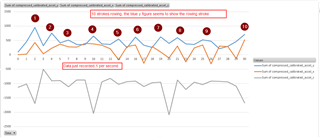The app I am working on is a Rowing Stroke Counter (with Companion Android App), I initially tried to use the Activitie's currentCadence but as discussed here it looks like that isn't going to fly, and I need to calculate strokes myself with Accelerometer data, (yipee!) so now I'm looking at Pitch Counter....I can see that it records Accelerometer data to FIT file, so I just started the App and rowed 10 strokes at 20strokes per minute...and then downloaded the FIT file, then exported as CSV using this tool
Just looking at the data (see screenshot) it looks like the Y axis is what I can use to count strokes.
My question though concerns the frequency of data recorded in the FIT file, I understand that the PitchCounter is sensing movements 25times/sec
var options = {:period => 1, :sampleRate => 25, :enableAccelerometer => true};
But it appears that the FIT file is only recording one entry per second.....can anybody explain? To properly analyse the stroke, I'll need multiple data points per second.



